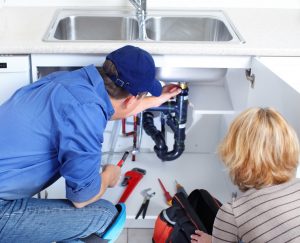In this article below you can find some superb details with regards to Why Is My Garbage Disposal Leaking From the Bottom?.

Waste disposal unit are important cooking area appliances that help in dealing with food waste efficiently. Nevertheless, a dripping waste disposal unit can be an aggravating and messy issue to deal with. The good news is, many leaks can be repaired easily with a couple of basic steps. In this write-up, we will discuss exactly how to take care of a dripping garbage disposal effectively.
Introduction
Waste disposal unit are mounted under cooking area sinks and are designed to shred food waste into smaller pieces, enabling it to travel through the pipes system conveniently. While these devices are normally reputable, leakages can happen with time due to wear and tear, loosened links, or damages to the system.
Typical Root Causes Of Leaks in Garbage Disposals
Worn Seals and Gaskets
Seals and gaskets play an important function in preventing water from leaking out of the waste disposal unit. In time, these parts can weaken, resulting in leaks around the disposal device.
Loose Links
The links between the garbage disposal and the pipes system can come to be loose gradually, triggering water to leakage out during operation.
Fractures or Holes in the Disposal Device
Physical damage to the garbage disposal, such as splits or openings in the housing, can additionally result in leakages.
Identifying the Resource of the Leak
Before attempting to deal with a dripping garbage disposal, it is vital to determine the source of the leak. This can typically be done with aesthetic examination or by performing straightforward examinations.
Visual Inspection
Examine the waste disposal unit system carefully for any kind of indications of water leak. Pay close attention to areas around seals, gaskets, and link points.
Evaluating for Leakages
One way to examine for leakages is by running water via the disposal unit and checking for any kind of visible signs of leak.
Tools and Products Needed for Repairing a Dripping Garbage Disposal
Prior to beginning the repair work process, gather the required tools and products, including a screwdriver, adjustable wrench, plumber's putty, substitute seals or gaskets, and epoxy or patching product for repairing cracks or openings.
Step-by-Step Guide to Repairing a Dripping Garbage Disposal
Turn Off the Power
Before attempting any kind of repair services, make sure that the power to the garbage disposal system is turned off to avoid the threat of electric shock.
Locate the Leakage
Determine the precise area of the leak and figure out the cause.
Tighten Links
Use a wrench to tighten any type of loose connections between the disposal unit and the plumbing system.
Replace Seals or Gaskets
If the leak is due to used seals or gaskets, remove the old parts and change them with new ones.
Patching Fractures or Holes
For cracks or holes in the disposal unit, usage epoxy or an appropriate patching material to secure the damaged location.
Examining the Waste Disposal Unit After Repair
As soon as the repair service is total, evaluate the garbage disposal by running water via it to make certain that the leak has actually been dealt with.
Preventive Upkeep Tips to Prevent Future Leakages
To avoid future leakages, it is necessary to click here execute routine maintenance on your waste disposal unit. This consists of maintaining it tidy, staying clear of placing non-food things or hard objects down the disposal, and periodically checking for leaks or various other concerns.
Conclusion
In conclusion, taking care of a dripping garbage disposal is a relatively straightforward procedure that can be completed with basic devices and materials. By following the actions described in this post and practicing precautionary upkeep, you can maintain your garbage disposal in good working condition and stay clear of costly repairs in the future.
What to Do About a Leaking Garbage Disposal
A leaking garbage disposal often goes unnoticed until you confront a sopping cabinet, a foul-smelling puddle, or an audible drip-drip-drip from the unit. The fix can be frustrating, too, because the leak can stem from a number of components in the system. Fortunately, with a little sleuthing, you can zero in on the leak and—depending on the exact location—stop the icky oozing and repair the component that caused it. Worst case scenario, if it turns out that the garbage disposal must be replaced, installing a new one is a reasonable do-it-yourself task for those with basic plumbing skills. Read on to keep the cash you’d otherwise hand over to a pro.
Prepare to find the leak
Prior to testing the garbage disposal for leaks, unplug it at the wall outlet and turn off the power from the breaker box to prevent electrical shock. Then insert a watertight sink stopper into your sink drain and wipe the unit dry with a clean cloth. In any handy container, mix a few drops of food coloring into a few cups of water, and pour the dyed water onto the sink stopper to help you locate the leak.
Investigate the source
the top, where the disposal meets the sink drain the side, where the dishwasher hose or main drain pipe connects to the disposal or the bottom of the unit Inspect each of these locations while gliding a light-colored rag over the unit; the dyed water will readily show on the rag and reveal the location of the leak. If a leak isn’t immediately apparent, remove the sink stopper and pour a few more cups of dyed water down the sink drain, then check for leaks again. Leaks near the top of the unit are more likely to show themselves while the sink is plugged, while side and bottom leaks are more noticeable while the sink is unplugged.
The metal sink flange that sits directly inside the sink drain is typically sealed around the top with plumber’s putty (a clay-like sealant) and then secured from under the sink with bolts. If the plumber’s putty deteriorates, or the bolts loosen, the flange can no longer form a watertight seal between the sink drain and the disposal—which could cause a leak at the top of the unit.
To reseal the leaky flange, you must first detach the garbage disposal. Start by loosening the screws securing the main drain pipe to the disposal, then loosen the screws in the metal clamp securing the dishwasher hose to the disposal and detach the drain pipe and dishwasher hose from the disposal. Loosen the screws in the mounting ring that connects the disposal to the metal mounting assembly beneath the sink, then pull down the disposal and carefully set it on a clean, dry surface. Loosen the bolts in the mounting assembly with a wrench, then pull down the mounting assembly and set it near the disposal.

We were introduced to that article about Garbage Disposal Leaking From Bottom from a friend on a different web address. Appreciated our posting? Please share it. Let someone else find it. Many thanks for taking the time to read it.
Call Today